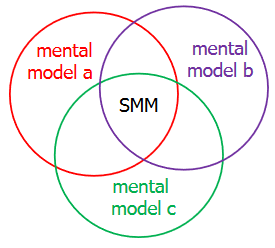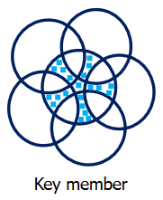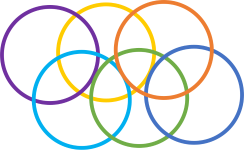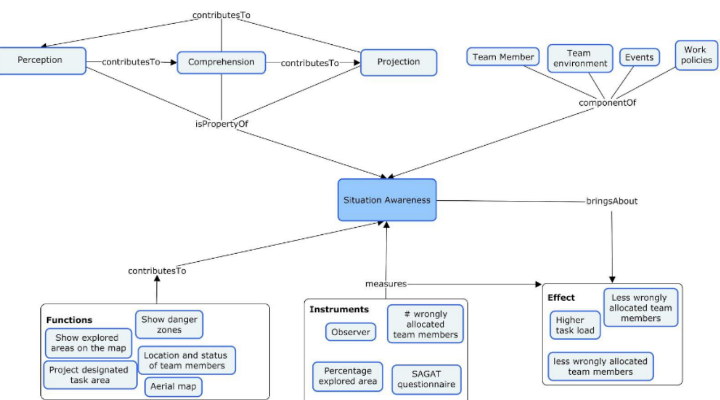Human-Agent Teamwork
Teamwork concepts:
- Joint activities
- Interpredictability
ability, to predict what others will do (foresee if someone needs help e.g. exit the train with a baby stroller) - Common ground
team has to have mutual knowledge, beliefs, and assumptions about others' skills or capabilities -> related to the Ontology in our project - Directability
individuals can modify actions of the others, as well as conditions and priorities
one can influence others, they react to the influence
- Interpredictability
- shared mental model
- Mental Model
- = internal representation of the world, which is used to describe, explain and predict
- related to 'theory of mind'
- a theory of mind enables the ability to attribute mental states (beliefs, intentions, emotions, desires) that are different from one's own
example: Richard believes that Mary intends him to persuade Albert that...
- Shared mental Model

- 'overlap' of individual mental models, knowledge representation shared by team members
*same use as a mental model, but for team behavior (describe, explain, predict) - allows coordination and adaption of changes
- 'overlap' of individual mental models, knowledge representation shared by team members
- Mental Model
- Team Structures
- Teams with key members (manager)
- Teams with subteams
- Teams with changing team members (!avoid loss if knowledge)


Our Team structure:

In our group, we had a dynamic change of responsibility and workload. Normally we split the work during the week into smaller parts and shared it between all 6 group members or divided it into smaller teams. At the beginning of next week, we shared our progress within the XWiki or in a short meeting to be back on the same level. Using this team structure all of us were able to continue working on each part and we were flexible enough to take care of personal difficulties (almost everyone of us was sick during the quarter or had urgent submissions).
The XWiki helped to share knowledge between the team members. Also, it was a good possibility to re-read what others wrote down and add more details. Throughout the quarter we changed, corrected and improved almost each page in an iterative process.
Conceptions and Knowledge process
- Transactive Memory System (TMS)
- memory system, that is distributed across different team members
- not everyone has to know all, but has to have knowledge about who knows what and own expertise
- is supposed to predict team performance
- Situation awareness
- Is the perception of elements in the environment within a volume of time and space
the comprehension of their meaning and
the projection of their status in the near future. - activated knowledge about current situation (focusing on perception, cognition and action) is used to describe, explain and predict team performance
- if situation awareness is missing, accidents can happen
- important in domains with high information load and high costs of errors
- examples where SA is needed:
- when tasks are transferred from AI/ Machine to human (e.g. autonomous driving, flying)
- awareness for resilience (e.g. policemen wearing smartwatch to connect with team members)
- Is the perception of elements in the environment within a volume of time and space
- Team shared situation awareness
Team SA- every team member has their own subgoal (that is part of teamgoal)
- every team member has SA for its own responsibility (to reach subgoal)
- Shared SA
- team members have SAME SA
Example
Robot Assisted Disaster Response
- used for Earthquakes in Italy, Industrial fire

a shared situation report (like a map with markings) can improve the performance of the team
Task Management
coordination of dependencies between activities to accomplish team goal/ harmonious combination
Types of coordination:
- Bottom up coordination
Flocking behavior of birds - Top down coordination
hierarchy in companies
Workload
- cognitive load (e.g. time occupied, level of info processing)
- physical load
- affective load (expected cognitive load, severity level of current task)
- physical state
- emotional state (arousal, valence)
- workload needs to be balanced; e.g. robot can cope with more physical load than human
- Feedback on emotional and physical state helps to improve the team performance, but team member privacy should be considered, always balance between the team performance and the individual team member privacy! (for example with information sharing policies)
- use notifications, to inform team members about an overflow of workload
remark on types of workload: only physical and cognitive workload is represented in the team design patterns (boxes that are carried over the head). The affective load is not shown, maybe because it's subjective and hard to measure, but it should be considered in the design process as well